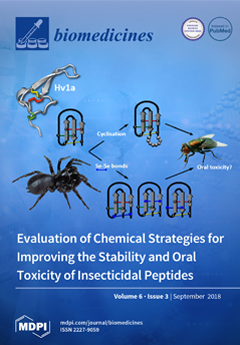The rapid development of the cancer stem cells (CSC) field, together with powerful genome-wide screening techniques, have provided the basis for the development of future alternative and reliable therapies aimed at targeting tumor-initiating cell populations. Urothelial bladder cancer stem cells (BCSCs) that were
[...] Read more.
The rapid development of the cancer stem cells (CSC) field, together with powerful genome-wide screening techniques, have provided the basis for the development of future alternative and reliable therapies aimed at targeting tumor-initiating cell populations. Urothelial bladder cancer stem cells (BCSCs) that were identified for the first time in 2009 are heterogenous and originate from multiple cell types; including urothelial stem cells and differentiated cell types—basal, intermediate stratum and umbrella cells Some studies hypothesize that BCSCs do not necessarily arise from normal stem cells but might derive from differentiated progenies following mutational insults and acquisition of tumorigenic properties. Conversely, there is data that normal bladder tissues can generate CSCs through mutations. Prognostic risk stratification by identification of predictive markers is of major importance in the management of urothelial cell carcinoma (UCC) patients. Several stem cell markers have been linked to recurrence or progression. The CD44v8-10 to standard CD44-ratio (total ratio of all CD44 alternative splicing isoforms) in urothelial cancer has been shown to be closely associated with tumor progression and aggressiveness. ALDH1, has also been reported to be associated with BCSCs and a worse prognosis in a large number of studies. UCC include low-grade and high-grade non-muscle invasive bladder cancer (NMIBC) and high-grade muscle invasive bladder cancer (MIBC). Important genetic defects characterize the distinct pathways in each one of the stages and probably grades. As an example, amplification of chromosome 6p22 is one of the most frequent changes seen in MIBC and might act as an early event in tumor progression. Interestingly, among NMIBC there is a much higher rate of amplification in high-grade NMIBC compared to low grade NMIBC.
CDKAL1,
E2F3 and
SOX4 are highly expressed in patients with the chromosomal 6p22 amplification aside from other six well known genes (
ID4,
MBOAT1,
LINC00340,
PRL, and
HDGFL1). Based on that,
SOX4,
E2F3 or 6q22.3 amplifications might represent potential targets in this tumor type. Focusing more in
SOX4, it seems to exert its critical regulatory functions upstream of the Snail, Zeb, and Twist family of transcriptional inducers of EMT (epithelial–mesenchymal transition), but without directly affecting their expression as seen in several cell lines of the Cancer Cell Line Encyclopedia (CCLE) project.
SOX4 gene expression correlates with advanced cancer stages and poor survival rate in bladder cancer, supporting a potential role as a regulator of the bladder CSC properties.
SOX4 might serve as a biomarker of the aggressive phenotype, also underlying progression from NMIBC to MIBC. The amplicon in chromosome 6 contains
SOX4 and
E2F3 and is frequently found amplified in bladder cancer. These genes/amplicons might be a potential target for therapy. As an existing hypothesis is that chromatin deregulation through enhancers or super-enhancers might be the underlying mechanism responsible of this deregulation, a potential way to target these transcription factors could be through epigenetic modifiers.
Full article






